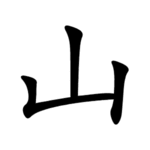Radical 46
| 山 | ||||
|---|---|---|---|---|
| ||||
| 山 (U+5C71) "mountain" | ||||
| Pronunciations | ||||
| Pinyin: | shān | |||
| Bopomofo: | ㄕㄢ | |||
| Gwoyeu Romatzyh: | shan | |||
| Wade–Giles: | shan1 | |||
| Cantonese Yale: | sāan | |||
| Jyutping: | saan1 | |||
| Pe̍h-ōe-jī: | san | |||
| Japanese Kana: | サン san (on'yomi) やま yama (kun'yomi) | |||
| Sino-Korean: | 산 san | |||
| Names | ||||
| Chinese name(s): | (Left) 山字旁 shānzìpáng (Top) 山字頭/山字头 shānzìtóu (Bottom) 山字底 shānzìdǐ | |||
| Japanese name(s): | 山/やま yama (Left) 山偏/やまへん yamahen (Top) 山冠/やまかんむり yamakanmuri | |||
| Hangul: | 메 me | |||
| Stroke order animation | ||||
 | ||||
Radical 46 or radical mountain (山部) meaning "mountain" is one of the 31 Kangxi radicals (214 radicals total) composed of three strokes. It is found in the names of mountains generally in east Asia.
In the Kangxi Dictionary, there are 636 characters (out of 49,030) to be found under this radical.
山 is also the 39th indexing component in the Table of Indexing Chinese Character Components predominantly adopted by Simplified Chinese dictionaries published in mainland China.
In Taoist cosmology, 山 (mountain) is the nature component of the bagua diagram 艮 gèn. This diagram corresponds to the I Ching trigram ☶.
Evolution
-
 Oracle bone script character
Oracle bone script character -
 Bronze script character
Bronze script character -
 Large seal script character
Large seal script character -
 Small seal script character
Small seal script character
| Strokes | Characters |
|---|---|
| +0 | 山 |
| +1 | 乢 (=蓋 -> 艸) 屲 |
| +2 | 屳 屴 屵 屶JP (also obsolete variant form of 會 -> 曰) 屷 (=會 -> 曰) |
| +3 | 屸 屹 屺 屻 屼 屽 屾 屿SC (=嶼) 岀 (=出 -> 凵) 岁SC (=歲) 岂SC (=豈) 岃 |
| +4 | 岄 岅 (=阪 -> 阜) 岆 岇 岈 岉 岊 岋 岌 岎 岏 岐 岑 岒 岓 岔 岕 岖SC (=嶇) 岗SC (=崗) 岘SC (=峴) 岙SC (=嶴) 岚SC (=嵐) 岛SC (=島) 岜 |
| +5 | 岝 岞 岟 岠 岡 岢 岣 岤 岥 岦 岧 岨 岩 岪 岫 岬 岭SC (=嶺) 岮 岯 岰 岱 岲 岳 岴 (=嶇) 岵 岶 岷 岸 岹 (=岧) 岺 岻 岼 岽SC (=崬) 岾 岿SC (=巋) 峀 峁 峂 峃SC (=嶨) 峄SC (=嶧) 峅JP |
| +6 | 岍 峆 峇 峈 峉 峊 峋 峌 峍 峎 峏 峐 峑 峒 峓 峔 峕 (=時 -> 日) 峖 峗 峘 峙 峚 峛 峜 峝 (=峒) 峞 峟 峠JP 峡SC/JP (=峽) 峢 (=峛) 峣SC (=嶢) 峤SC (=嶠) 峥SC (=崢) 峦SC (=巒) 峧 |
| +7 | 峨 峩 (=峨) 峪 峫 峬 峭 峮 峯HK variant (=峰) 峰 峱 峲 峳 峴 峵 島 峷 峸 峹 峺 峻 峼 峽 峾 峿 崀 崁 崂SC (=嶗) 崃SC (=崍) 崄SC (=嶮) 崅 |
| +8 | 崆 崇 崈 (=崇) 崉 崊 崋 崌 崍 崎 崏 崐 (=崑) 崑 崒 崓 崔 崕 (=崖) 崖 崗 崘 (=崙) 崙 崚 崛 崜 崝 崞 崟 崠 崡 崢 崣 崤 崥 崦 崧 崨 崩 崪 崫 崬 崭SC (=嶄) 崮 崯 崰 |
| +9 | 崱 崲 崳 崴 崵 崶 崷 崸 崹 崺 崻 (=峙) 崼 崽 崾 崿 嵀 嵁 嵂 嵃 嵄 嵅 嵆 嵇 嵈 嵉 嵋 嵌 嵍 嵎 嵏 嵐 嵑 嵒 (=岩) 嵓 (=岩) 嵔 嵕 嵖 嵗 (=歲 -> 止) 嵘SC (=嶸) 嵙 嵚SC (=嶔) 嵛 嵜 (=崎) 嵝SC (=嶁) |
| +10 | 嵊 嵞 嵟 嵠 嵡 嵢 嵣 嵤 嵥 嵦 嵧 嵨 嵩 嵪 嵫 嵬 嵭 嵮 嵯 嵰 嵱 嵲 嵳 嵴 嵵 嵶 |
| +11 | 嵷 嵸 嵹 嵺 嵻 嵼 嵽 嵾 嵿 嶀 嶁 嶂 嶃 (=嶄) 嶄 嶅 嶆 嶇 嶈 嶉 嶊 嶋 (=島) 嶌 (=島) 嶍 嶎 |
| +12 | 嶏 嶐 嶑 嶒 嶓 嶔 嶕 嶖 嶗 嶘 嶙 嶚 (=嶛) 嶛 嶜 嶝 嶞 嶟 嶠 嶡 嶢 嶣 嶤 嶥 |
| +13 | 嶦 嶧 嶨 嶩 (=峱) 嶪 嶫 嶬 嶭 嶮 嶯 嶰 嶱 嶲 嶳 嶴 嶵 嶶 |
| +14 | 嶷 嶸 嶹 嶺 嶼 嶽 嶾 嶿 |
| +15 | 巀 巁 巂 |
| +16 | 嶻 巃 巄 (=巃) 巅SC (=巔) |
| +17 | 巆 巇 巈 巉 巊 巋 巌JP (=巖) |
| +18 | 巍 巏 巐 |
| +19 | 巎 巑 巒 巓 (=巔) 巔 巕 巗 (=巖) |
| +20 | 巖 巘 巙 巚 (=巘) |
Sinogram
The radical is also used as an independent Chinese character. It is one of the kyōiku kanji or kanji taught in elementary school in Japan.[1] It is a first grade kanji.[1]
References
- ^ a b "The Kyoiku Kanji (教育漢字) - Kanshudo". www.kanshudo.com. Archived from the original on March 24, 2022. Retrieved 2023-05-06.
Literature
- Fazzioli, Edoardo (1987). Chinese calligraphy : from pictograph to ideogram : the history of 214 essential Chinese/Japanese characters. calligraphy by Rebecca Hon Ko. New York: Abbeville Press. ISBN 0-89659-774-1.
- Lunde, Ken (Jan 5, 2009). "Appendix J: Japanese Character Sets" (PDF). CJKV Information Processing: Chinese, Japanese, Korean & Vietnamese Computing (Second ed.). Sebastopol, Calif.: O'Reilly Media. ISBN 978-0-596-51447-1.
See also
External links

- Unihan Database - U+5C71
- v
- t
- e
- 211 齒
- 214 龠


















